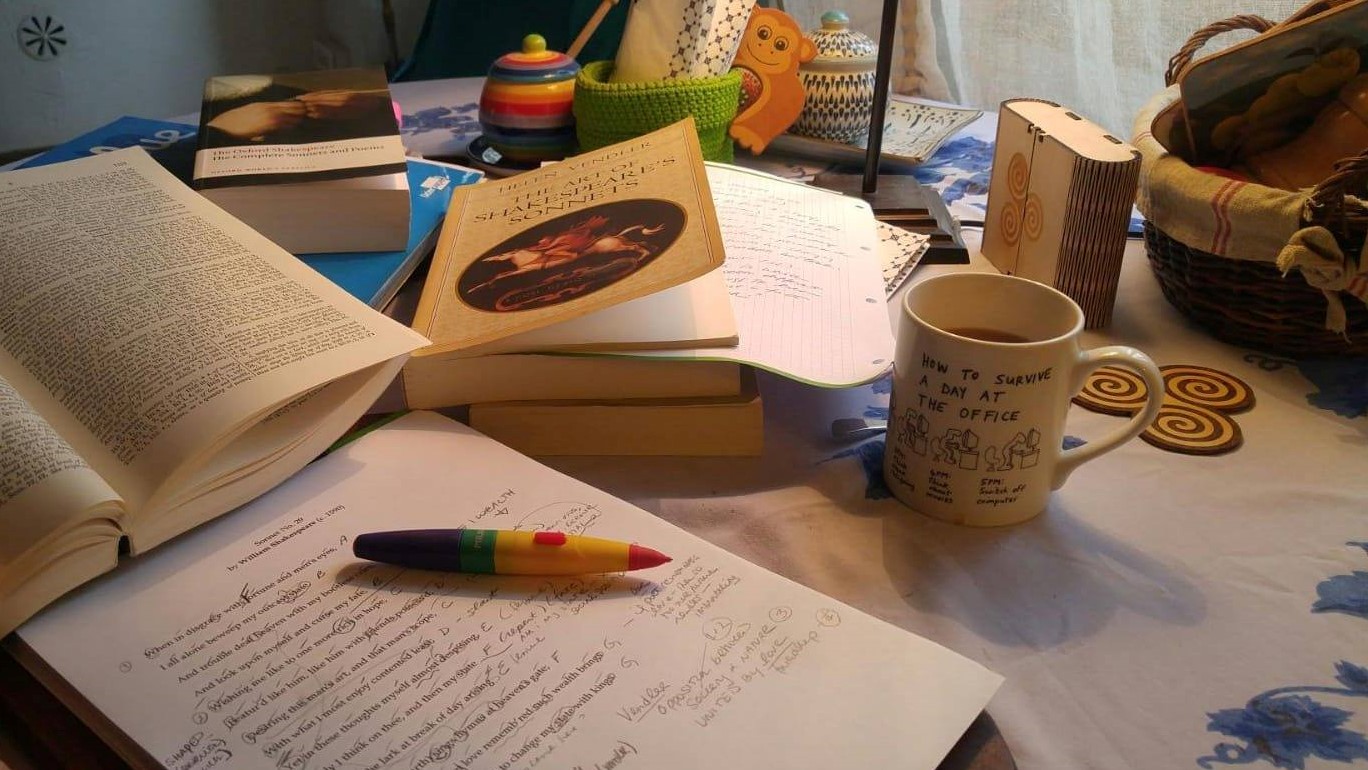Venturing Beyond my “Zone of Personal Development” by Natalie Spengler
I have always been someone who has loved school.
Growing up, there was no better feeling than the mix of butterflies and excitement I felt at the beginning of each school year. Nothing could compare to the sight of my brand-new crayons
neatly arranged in colourful rows or the crisp feel of my freshly covered notebooks. As a teacher, this love of order and precision translated into the thrill of decorating a bulletin board to mark the start of a new school year, colour-coordinating pencils in individual containers and striving to outdo myself in terms of classroom decorations. Within my neatly organised comfort zone, I would often feel frustrated when my students didn’t understand new concepts as quickly as I felt they should, or if they were unmotivated to do their work. How could students not be doing their homework when I had spent so much time decorating a cute homework notice board with helpful reminders for them?
A few years ago, I took a surfing lesson in Costa Rica. No matter how hard I tried to follow the instructor, I just couldn’t stand up on my board for more than a few seconds. I tried over and over again without success and fell off my board every time. Cognitively, I understood what I was supposed to do, but I couldn’t put it into practice. As I was tumbling about in the ocean, with salt water and tears of frustration stinging my eyes, it made me wonder how many of my students were stuck inside a similar nightmare of panic with no sense of control over what they were doing. Was I creating unrealistic expectations for my students to follow? After taking various professional development courses, I became more interested in evidence- based strategies to support real learning in the classroom. As a teacher who has worked mainly with English language learners, Vygotsky’s theory of the Zone of Proximal Development (1978) has especially captured my interest. I began to think about how to develop better support structures to engage all learners to allow them to be more active in their learning. At the end of each class, I have learned to think critically about the lesson and ask myself, “what did each student learn today?”.
After nine years of teaching upper primary students in Costa Rica, and taking a year-long break to complete a master’s programme in Education, I am now in my second year of teaching at an international high school in China. During my first few months I was challenged to rethink every single strategy that had worked perfectly in the past. It felt like I was a novice teacher starting from scratch. I forced myself to scale back my expectations and focus on evidence-based practices. I continue to ask myself and my students about their learning gains, and how to make lessons and activities work better for them.
For someone who loves the structure of a day punctuated by school bells, neat handwriting and new pencils, it has been a valuable and humbling lesson to be pushed out of my comfort zone. While everyone’s step out of their comfort zone may look a little bit different, I encourage you to give it a try.
Reference:
Vygotsky, L. S. (1978). Mind in society: The development of higher psychological processes. Cambridge, MA: Harvard University Press.
“Where are you from, teacher?” by Vera Babkina
I think every teacher who has experience working abroad, has heard this one, right?
The thing about working in Asian countries though (and I have spent the last 5 years teaching first in China, and now in Vietnam) is that some schools will not want all of their teachers to answer this question truthfully. Some schools even go as far as ask their teachers to lie. Obviously, only non-native speaking English teachers have to do it. Trust me, I know. Been there, walked away from the school.
Yes, I am not objective, this is personal. I’m a non-native speaking English educator.
The discriminatory situations like this are happening because of the prevalent stereotype among management and parents about “native Englishness”. The stereotype that only a native-speaking teacher can provide a good linguistic model, be that in terms of grammar, lexical range or pronunciation. And this is one of the most hurtful things personally for teachers like me. I have been learning and improving my English for decades, to the point where I chat to a new native-speaking colleague in the teacher’s room and they cannot guess where I come from based on my accent or general use of English. In fact, such a stereotype was proven wrong by research, for example, according to Keeratikan and Sucharat’s (2020) analysis, both educators and learners agreed that NNEST can develop the student’s proficiency to higher scores.
There is a very strong bias in many Asian countries to hiring only NES teachers (Walkinshaw, Duong, 2012; Wang, Fang, 2020). And a lot of schools who do hire NNES teachers ask them to not advertise their country of origin.
Holliday (2008) introduces the term of “English-speakerism” and pretty much summarizes the situation:
I have heard influential employers [in the English language teaching industry] in Britain say that while they would abolish the discriminatory differentiation between ‘native speakers’ and ‘non-native speakers’ tomorrow, they can’t because their ‘customers demand it’. (p. 121)
In my latest experience at an interview, a manager said, “Well, having spent a lot of time in Australia, I welcome the variety. But you know, the parents…” Actually, yes, I know. But I also know that the research in Vietnam and China also shows that a large percentage of students care much more about the teaching experience, friendliness and teaching practices of the teacher rather than their “nativeness” (Walkinshaw, Duong, 2012). I also know that the parents are usually not professionals in the field of education. The schools are. So, why not educate your clients?
Defend your choice of professionals by explaining that you value experience and qualifications over the “right” passport. That the studies report: the students actually find it helpful when the teacher can draw on their own experience in acquiring the language (Wang, Fang, 2020). They feel that a NNES teacher can relate to their struggle and find more efficient ways to explain difficult concepts. In fact, some of my NES colleagues here in Vietnam admitted in private conversations that they are quite often not sure how to answer a student’s question about a certain grammar point, just because they never though about the theoretical aspect of it. They are native-speakers, so “that’s just how we say it”. Not always the best explanation for someone learning a new language.
Parents are worried about pronunciation? Fair enough, but the research from your own country shows that students’ attitude varies and a lot value clear pronunciation more than “native” (Walkinshaw, Duong, 2012 citing Pacek, 2005). More often than not I hear “Which part of the USA are you from?” because the students or parents cannot differentiate between “native” and neutral non-native accent anyway. Actually, I am from Russia, but you definitely wouldn’t guess this from my accent.
Another interesting point about all the native/non-native dichotomy is that it does harm native-speaking teachers as well. It goes without saying that the native-speaking countries’ population comprises of the people from all kinds of backgrounds. And not all of them fall into the stereotypical category of tall white foreigner with blonde hair and blue eyes, which is a common perception of a “native speaker” in many Asian countries (Comprendio, Savski, 2019). And – surprise! – they get discriminated on par with the NNES teachers, even though they come from the “right” countries. This is something I also know about very well, as my husband, an amazing, experienced teacher passionate about his job, is a mixed descent Canadian. He looks Asian and, sadly enough, a lot of schools use the same twisted logic of “parents want Western native-speakers” when it comes to the interviews.
Hopefully, with more and more research on students’ perception and results, the policies and attitudes will change towards less discriminatory job market. Let us judge the teachers by their expertise, experience and teaching practices rather than their passport. After all, there are more and more non-native speaking teachers in the word every year, and a lot of them are great professionals.
Vera Babkina
Kung Fu Shakespeare – by Anne Ryan Hanafin
‘Pupils may understand more than we believe they do.’
John Gordon (2015)
I called them ‘the Kung Fu group’. Every time I went outside to assess their progress, someone was either crawling up the side of the building or throwing some old school Bruce Lee shapes, to the embarrassed delight of six classmates. Unfortunately, this was not Phys Ed. It was English literature, and my seven warriors in training were supposedly rehearsing a choral recitation of Shakespeare’s Sonnet #29.
Neither I nor the Bard of Avon could really blame them. Our lycée, located in sunny southern Europe, is set into an intricately terraced series of hillsides. Its buildings curl their way across the landscape, blessing many classrooms with access to exterior courtyards protected by pine and olive trees. On early autumn days like this one, breezes from the not-so-distant sea bring a sharp, woody scent into the classroom. And so my teaching partner and I liberally interpreted the latest COVID protocols, sending our twenty-one students outside, to work in the open air.
The Kung Fu group embodied the rich variety of students enrolled in the American section of our OIB program. They were 2nde level, roughly equivalent to UK Key Stage 4, or sophomores in an American high school: full of physical energy and perhaps lacking in maturity, but always eager to talk and be heard, each student a multilingual learner to whom the EAL acronym did not seem to accurately apply. Many have been speaking their native language interchangeably with English since childhood, while others speak two or three additional languages with equal ease. But skill levels are mixed in our section, resulting in a constant susurrus of voices in the classroom beneath the flow of instruction in English. It has taken me some time to understand that this is not a sign of disrespect, but active engagement, as more fluent students work quietly to aid colleagues who struggle with comprehension.
The choral Shakespeare recitation, which takes a passage designed for a single voice and distributes the lines amongst multiple speakers, is a challenging exercise, even in the context where I first encountered it, during MFA-level training in Shakespearean performance technique. Thanks to our OIB programme’s insistence on the centrality of poetry to English literature curriculum, my students already possessed strong practical understanding of the inner workings of a poem. However, this exercise asked them to dig deeper, to move beyond what I call “literary terminology bingo” towards an examination of the connection between sound and emotion. In just twenty-five minutes of group work, they needed to develop a coherent, nuanced, multi-voiced recitation of one of the most renowned sonnets in the English language. This was asking a lot, and I knew it.
Back outside, two of my three groups were working steadily. One group focused on caesuras and enjambment as a way to drive emotional impact. The other clarified pace and pronunciation for non-native English speaking colleagues. Around the corner, a young man in the Kung Fu crowd was jumping off a trash can. I sighed and called everyone back into the classroom.
Whether by accident or design, the other two groups presented first. These recitations were excellent examples of learning objectives acquired and applied. Lines were divided into precise phrases which respected meaning and produced interesting tonal effects. Their understanding of the language was accurate, their diligence impressive. But somehow there was a spark missing. I shook off the thought, chalking it up to fatigue, and asked the Kung Fu group to come to the front of the room. Up they shambled, and proceeded to astound us. Their group of seven was split almost equally along gender lines, and they physically arranged themselves in an alternating boy-girl pattern. Crucially, they assigned full lines in the sonnet in the same manner, alternating by gender and rarely splitting lines between voices, bringing an engaged excitement to the movement of the text. I realised I was listening to something innovative, a welcome variation on conventional interpretations of this beloved poem. Instead of the thoughts of an individual voice, I was hearing a dialogue: perhaps between Lover and Beloved, or a conversation between inner and outer speech.
At the centre of the line, the group had placed the student with the strongest English language skills, assigning him the closing lines. No critical analysis of mine regarding the significance of Shakespearean rhyming couplets could have been as powerful as hearing that young man’s voice ring out confidently in the classroom: “For thy sweet love rememb’red such wealth brings / That then I scorn to change my state with kings.”
Anne Ryan Hanafin



